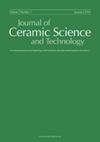Measurement of the volume expansion of SiC refractories induced by molten salt corrosion
IF 0.4
4区 材料科学
Q4 MATERIALS SCIENCE, CERAMICS
引用次数: 4
Abstract
Corrosion tests of oxide-bonded SiC-based refractory cylinders with molten salts (mainly CaSO4, K2SO4) were performed at high temperature to enable better understanding of the corrosion mechanisms operating in these materials. Salt pellets were placed on the upper surface of small refractory cylinders. After they had been melted, the corrosive product soaked into the pores of the refractory cylinders and partially corroded the SiC phase. SEMEDS analyses showed thatCaSiO3 was the mainnewphase formed, growing from SiC aggregates into the pores.Theshapes of the initial and corroded cylinders were measured at room temperature using a 3D coordinate measuring machine equipped with a laser-plane sensor. These measurements enabled monitoring of the evolution of the residual radial deformation versus the depth from the surface in contact with the salt pellets, and consequently the characterisation of the local volume expansion induced by the phase change. Coupling SEM-EDS analyses with 3D digitising revealed the link between the corrosion product and the volume expansion.熔盐腐蚀下碳化硅耐火材料体积膨胀的测定
为了更好地了解这些材料的腐蚀机理,在高温下对氧化键sic基耐火材料钢瓶进行了熔盐(主要是CaSO4、K2SO4)的腐蚀试验。盐球放置在小型耐火钢瓶的上表面。熔化后,腐蚀产物渗入耐火钢瓶的孔隙中,部分腐蚀SiC相。SEMEDS分析表明,形成的主要新相为casio3,由碳化硅聚集体向孔隙中生长。使用配备激光平面传感器的三维坐标测量机在室温下测量初始圆柱体和腐蚀圆柱体的形状。这些测量可以监测残余径向变形随与盐丸接触的表面深度的演变,从而表征由相变引起的局部体积膨胀。耦合SEM-EDS分析和3D数字化揭示了腐蚀产物与体积膨胀之间的联系。
本文章由计算机程序翻译,如有差异,请以英文原文为准。
求助全文
约1分钟内获得全文
求助全文
来源期刊

Journal of Ceramic Science and Technology
MATERIALS SCIENCE, CERAMICS-
CiteScore
0.80
自引率
0.00%
发文量
0
期刊介绍:
The Journal of Ceramic Science and Technology publishes original scientific articles on all topics of ceramic science and technology from all ceramic branches. The focus is on the scientific exploration of the relationships between processing, microstructure and properties of sintered ceramic materials as well as on new processing routes for innovative ceramic materials. The papers may have either theoretical or experimental background. A high quality of publications will be guaranteed by a thorough double blind peer review process.
 求助内容:
求助内容: 应助结果提醒方式:
应助结果提醒方式:


